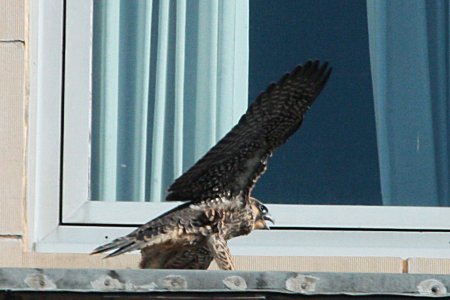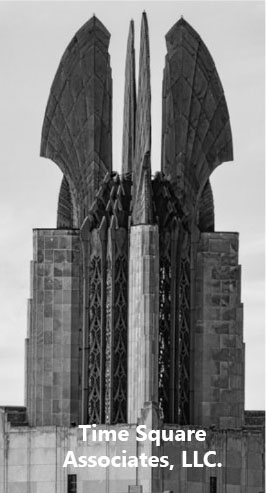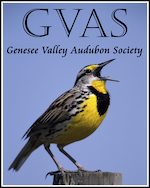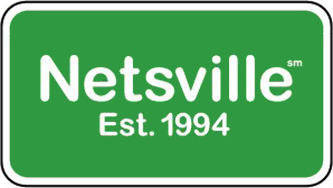So You Want to Be A Fledge Watcher?

If you missed our recent Fledge Watcher Orientation meeting, don’t despair! You can still participate.
First, download and print a copy of our 2008 Fledge Watch Brochure. The brochure provides an overview of information that you need to be a successful fledge watcher. It includes a list of contact numbers, recommended fledge watching gear and instructions for how to rescue a downed fledgling.
Next, check out the Fledge Watch Calendar. Fledge watch shifts are available from 7AM to 9PM every day from now through mid-July. You can sign up for as many or as few shifts as you want. We request that shifts be two hours in duration or more, but whatever amount of time you can volunteer will be greatly appreciated! And don’t worry if you see that someone else has signed on to the same time you’d like to watch. The more watchers we have out at one time, the better we can cover all the ground once the fledglings start really flying.
When you decide on which shift(s) you’d like to take, send an email to Lisa McKeown, our Fledge Watch Coordinator. You can reach her at either of the following addresses:
gladyshall@gmail.com or
sponsorship@rfalconcam.com
Be sure to include your name and the dates & times for the shift or shifts you’re interested in filling. And to make it easy for Lisa to pick out your email from all the rest, be sure to include the words “Fledge Watch” in the subject line.
While you’re looking at the calendar, take a moment to browse the other pages at the Rochester Falconcam’s FalconWatch Blog. We’ve included helpful guidelines for posting your fledge watch reports and using the FledgeWatch blog. You won’t be able to post your report on the FalconWatch blog until you’ve been accepted as an author at the blog. We’ll send you a username and password that will allow you to post your fledge watch reports.
Finally, have fun! Fledge Watching provides a rare opportunity to see one of nature’s true marvels up close, and to help ensure the safety of the fledglings. You’ll most likely find a group of “regulars” nearby who’ll be happy to walk you through the basics, so come one come all, and join the 2008 Fledge Watch!
-Jess



June 22nd, 2008 at 12:41 AM
Food drop!
June 22nd, 2008 at 12:46 AM
Mariah has joined Seneca for dinner.
June 22nd, 2008 at 11:50 AM
Sunday@6:49am Seneca is on the perch rail!
June 22nd, 2008 at 1:22 PM
All the falcons that are banded have silver bands – the one whose band is called “silver” (some see it as grey – it is probaly aluminium) does not have any colored tape on top of the silver official band with a long registration number. On the other leg they all have the same color combinations (green and black) with easy to read letter and number combinations. In the course of the next year the colored tape will wear off and we will only have the original bands to go by. Red, Green, Blue – those colors are used in most bandings where there is a big audience. In Harrisburg the colors subsitute for names during fledgewatch.
Yes, it is harder to see their legs than their beaks, but nail polish is so full of various chemicals that I would hate to see it near their mouths where they might ingest some as it flakes off, which it would do with the same rapidity that it does from people’s fingernails.
June 22nd, 2008 at 1:29 PM
Did Seneca just leave for a fly try out?
June 22nd, 2008 at 1:32 PM
Gary, the falcons didn’t do fine on their own. They were becoming extinct. That is why we have the nest boxes. The color would wear off. And I didn’t say to paint their whole beak. Still think it would be a good idea.
At this age, there is not too much personality to distinguish them by. Maybe with a movie camera-. Or if one could watch all day. They have just been acting ike babies with their mouths open waiting for handouts.
June 22nd, 2008 at 1:54 PM
Seneca is definitely out of the box!
June 22nd, 2008 at 2:05 PM
Thanks ENB for putting the REAL day/time that Seneca left the next box. I would have wondered!
June 22nd, 2008 at 4:24 PM
At this age, there is not too much personality to distinguish them by.
I completely disagree. They are each very unique and different, and have their own personalities and traights which makes this whole experience enjoyable. If you read through the comments, you’ll find that others have found certain aspects of each eyas that creates a small “fan” base for each. Sometimes it’s just circumstances that creates the characteristics.
It doesn’t really matter to me. Being able to “share” a glimpse into nature to watch and enjoy this entire process is wonderful. From start to finish – you can appreciate so much just by watching!
June 22nd, 2008 at 5:29 PM
Seneca finally did it! She has gone to join her family sometime between noon and 12:30 I believe!
June 22nd, 2008 at 5:34 PM
Debbie-I last saw her on cam with her wings spread at 12:17, then she was gone. She may be out of view in the playpen. Guess we’ll have to wait for reports from the ground!
June 22nd, 2008 at 5:43 PM
I’m sadden to see that Seneca has flown the coop ! But I am happy that she is going to be with the rest of her family. Go fly ! Seneca 🙂
June 22nd, 2008 at 6:36 PM
Good Heavens, you folks are hard to please 😀 first you are all het up that Seneca was not leaving the box, indeed that she was not moving i.e. dead… or at very least “lonely”, now some are upset that she is gone 😉
Seriously, it is sad to see the empty box, but there will be so many good watchers’ reports to take up the slack and pictures of the fledglings, some by Jim, but probably there will the others as well. Tom (Cornpoppy) and FalKenn wield a mean camera when they have time.
June 22nd, 2008 at 6:38 PM
Thanks Ei! In the last picture I saved, she was just sitting in the ledge by the scrape, pondering! In addition to others I’m sure, I have pics/slideshow of Mariah & her babies up thru today at http://albums.phanfare.com/KeyAlbums Falcon Cam Highlights.
June 22nd, 2008 at 6:43 PM
AJ wrote “Gary, the falcons didn’t do fine on their own. They were becoming extinct. ”
Small quibble, the falcons (and other raptors) WOULD have been doing fine on their own IF we humans had not interfered with their body chemistry.
It was only human intervention to stop the previous human intervention and repair its effects that got falcons back to where they are now. Indeed, they are doing pretty well on their own since many new falcons in observed nests (including those without any box) are unbanded (as Mariah is) showing that the population is coming back without direct human intervention.
June 22nd, 2008 at 7:45 PM
You’re right Alison in Austria…and the Bush Administraton hasn’t helped either:
Defending the ESA
Signed into law in the waning days of 1973, the Endangered Species Act (ESA) recently celebrated its 30th anniversary. The act and other wildlife legislation has helped bring peregrine falcons and other raptors back into our cities.
Despite this and other successes, the ESA is under attack by the Bush administration. A new report by Defenders of Wildlife, Sabotaging the Endangered Species Act, shows that the Bush administration has repeatedly abandoned scientific data on species status, ignored court orders to protect species and habitat, bowed to industry wishes regarding species and left the U.S. Fish and Wildlife Service under funded and incapable of fulfilling its responsibilities under the ESA.
In addition, the current administration has placed fewer plants and animals on the endangered species list than any previous administration. A number of U.S. raptor species remain listed under the act, including Audubon’s crested caracara, California condor, northern aplomado falcon, Hawaiian hawk, snail kite and three species of owls, and they require the protection of the federal government to survive.
June 22nd, 2008 at 7:47 PM
and this (which is kind of lengthy, but a good read):
Defenders Magazine
Winter 2004
The New Urban Flight
These days, city dwellers don’t need to go far to spot falcons, hawks and other birds of prey
By Bill Updike
© Jess Lee Devotees call it “the hawk bench.†At first glance, it’s a bench just like the many others scattered around New York City’s Central Park. What makes this one different is the people who gather there and the animal that piques their interest. The “hawk benchers†arrive as early as 5 a.m., and often don’t leave until after sunset, their eyes baggy and rimmed with indentations from binoculars or spotting scopes. The sight they’ve come to see would have been nearly unimaginable three decades ago: a red-tailed hawk plummeting down from its perch on a high-rise building to snap up an unsuspecting squirrel, pigeon or a tasty city rat.
Seeing the nearly two-foot-long, broad-winged, round-tailed hawks soaring and diving over the park gives the hawkaholics a connection with the wild world normally not available to those that live in metropolises such as New York City. According to E.J. McAdams, the executive director of New York City Audubon, the Central Park hawks give people a “sense that wildlife has returned to the city.â€
“I love knowing that, just because I live in a big city, it doesn’t mean that I have to be isolated from the natural world,†says Marie Winn, a regular hawk bencher and author of Red-Tails in Love, a popular book about Central Park’s birds. “I love the feeling of community I’ve found among my fellow Central Park birdwatchers and nature lovers, who, being city dwellers just as I am, might treasure the wilderness in our little urban enclave more than those who live out in the country and in the wide open spaces.â€
What the hawk benchers are witnessing in New York is part of a growing phenomenon around the country—the arrival of large birds of prey in the unfamiliar habitat of skyscrapers and roads. Since the 1970s, hawks, falcons and other raptors have populated cityscapes such as New York, Washington, D.C., Philadelphia, Chicago, St. Louis, Tucson, San Diego, Los Angeles, San Francisco and Montreal, among others. There are many reasons for the raptors’ urban advent, experts say: biologists have reintroduced the birds to urban areas; the harmful pesticide DDT was banned in the United States and Canada; the Endangered Species Act and other environmental legislation offer increased protection for raptors; the loss of wild habitat forces the birds to be more creative; ample perching spots allow raptors to hunt and avoid predators; and prey, such as songbirds, squirrels, pigeons and rats, is abundant year-round.
The glee with which city dwellers like the hawk benchers respond to the birds reflects a lack in our culture; too many people are too removed from nature. “For many urbanites, the raptors are the only contact they have with wildness,†says University of Arizona raptor researcher William Mannan. “There is tremendous aesthetic value to having these creatures in urban settings.â€
The joy of recreational viewers is mimicked by the scientists studying these birds, including people such as Robert Rosenfield, a professor of biology at University of WisconsinÂStevens Point. As a graduate student in 1980, Rosenfield spent weeks looking for Cooper’s hawks in Stevens Point, a city of 25,000 in central Wisconsin. Cooper’sÂwhich are short-winged, long-tailed hawks with blue-gray backs and rusty breastsÂwere listed as threatened in Wisconsin at the time, and other scientists said that his searches would be in vain, but he persevered. “I spent 10 to 12 hours a day busting a hump. One day I took a break and had driven by a spot with a nest in a tree. I backed up my AMC Gremlin and screeched the brakes. Sure enough, there was a nesting Cooper’s hawk,†Rosenfield recalls. He thought to himself, “Oh my god, I found the nest, and maybe the first in years in Wisconsin.†Rosenfield’s subsequent work has shown that Stevens Point has one of the highest nesting densities for Cooper’s hawks in North America.
Hawks, of course, are just one part of the urban raptor story. Another significant chapter is the comeback of the peregrine falconÂa foot-and-a-half-long bird with pointed wings and a signature black “mustache.†The peregrine, once found throughout the country, was nearly wiped out because of the use of DDT and other pesticides and herbicides, and because of the destruction of its habitat. By 1964, according to the American Museum of Natural History in New York, there were no breeding pairs of peregrine falcons east of the Mississippi River.
The peregrine was listed as endangered in 1970 under a law that preceded the current Endangered Species Act. In 1972, the Environmental Protection Agency banned DDT. The falconsÂalong with bald eagles and other raptorsÂbegan a slow climb back from the brink of extinction. They were given a helping hand by biologists who worked to reintroduce the birds to various urban and wild settings. In 1976, one such scientist, David Bird, a professor of wildlife biology at Montreal’s McGill University, was one of the first to reintroduce peregrines into a city (Montreal).
Today, thanks to the efforts of scientists, conservationists and legislators, peregrine falcons inhabit nearly 100 urban areas in North America. Many cities have several nesting pairs, says Bird. His own hometown of Montreal, which had one pair of peregrines in 1990, now has five pairs. Los Angeles also has five pairs. And the bustling metropolis of Chicago has 10 or more pairs of falcons, much to the delight of residents from all walks of life.
“What continually impresses me [is] the enthusiasm that people from all different backgrounds hold for the falcons; whether they are scientists, attorneys, engineers, window washers, salesmen, etc.,†says Mary Hennen, a scientist who monitors peregrines in Chicago for the Field Museum.
Despite their recent successes, though, urban raptors still face many threats. “There is no doubt that they face mortality that they normally wouldn’t encounter as muchÂflying into windows, being hit by vehicles, etc.,†says Mannan. Another threat is trichomoniasis, a disease that raptors get from eating pigeons and other doves. In Tucson, where Mannan does his work, research has shown that as many as 40 percent of Cooper’s hawks nestlings die from the disease. Mannan adds that the birds also can be exposed to high levels of toxins, usually as a result of eating prey that has been poisoned.
Allen Fish, director of the Golden Gate Raptor Observatory, works with a number of raptors in the San Francisco area and shares the concern of his fellow scientists. “I suspect the biggest challenge is direct human interference,†he says of his work with Cooper’s hawks in Berkeley, California. There are “just too many people altering the bird’s ability to behave normally.â€
“Even though they are avoiding predation, they seem to have found new ways for their young to die,†adds Bird. “They fly into mirrored buildings chasing prey or because of wind shears, fall down chimney shafts, get poisoned from eating pigeons who have been poisoned, and fly into the sides of trains or get hit by cars.â€
Despite the challenges, most biologists agree that city raptors are here to stay. The experts say we can help make the birds’ lives easier in several ways. Urban and suburban raptor fans can “encourage the utility industry to employ raptor-safe designs in their power-distribution equipment†so the birds won’t get electrocuted or fly into power lines, says Brian Millsap with the U.S. Fish and Wildlife Service, who has worked with bald eagles and owls in urban and suburban Florida. Millsap also recommends driving cautiously in areas frequented by raptors, covering windows to prevent birds from flying into them, and enjoying raptors from a distance, without disturbing them. Finally, he recommends learning “as much as you can about your local raptors so you can be an effective neighborhood advocate.â€
One of the best things that people can do, Rosenfield adds, is simply feed the birds on which the raptors prey. Of course, he notes, some people don’t like to see birds eaten by raptors. “I have encountered a number of times when people have a sharp aversion to predator presence. People say ‘we don’t need that predator taking out birds we are trying to feed.’†Some individuals have even asked him to trap and translocate the raptors so that they don’t have to see them.
Those who think pigeons and rats should have free reign over city streets may not herald the new age of urban raptors. The rest of us, who yearn for an experience of wildness in our own backyards or streets, may be found sitting on a bench like the one in Central Park, waiting and watching for the next swooping raptor.
Bill Updike is writer/editor for Defenders, and spends much of his free time photographing raptors and other wildlife.
June 22nd, 2008 at 8:08 PM
If you make it past the last post I just want to say that Seneca (I think) is in the play pen. She’s making progress. She just a “stay at home”.
June 22nd, 2008 at 8:54 PM
I like parts of the long post so much that I will take them over to some other fora I visit.
Thanks for the heads-up, AJ
June 22nd, 2008 at 8:55 PM
Heads up, fledgewatchers! Looks like Seneca’s about to take the plunge! At least I hope so. Sunday’s a better day to fledge; less traffic, more watchers.
I have mixed feelings seeing Seneca fledge. It marks the end of a long tradition in Rochester. Rather sad. Actually, the article above is a reminder of what’s likely to happen if Mariah leaves the area. Anyone who has ever lived in a city where pigeon droppings cover the park benches, cars, buildings knows what I mean.
June 23rd, 2008 at 12:30 AM
I miss little Seneca already. Anybody know how well that she did today? Also all of the others, but I got to really feel close to our little Seneca. Caye 7:30 pm.
June 23rd, 2008 at 12:33 AM
I miss little Seneca, already. I got so attached to her.
June 23rd, 2008 at 12:54 AM
GEE, this has been so much fun. Please how are they all doing?
June 23rd, 2008 at 3:59 AM
All is well. All five accounted for. Seneca is still in the playpen, running around and flapping her wings. 😉 Be sure to read the Fledge Watch reports. I’m sure there will be many of them over the next few weeks. – Carol P.
June 24th, 2008 at 3:33 AM
Where is the best place to read about the falcons. Probably two years ago we had pictures and messages from folks that they had seen the birds on the bridge and other places along with pictures.
Has Mariah and Kaver started teaching them to catch food in the air yet? Read some of the fledge watch this AM but didn’t see much about the older kids.
Seneca hasn’t returned to the box ever has she?
Hope you have better night pictures next year.
June 24th, 2008 at 4:24 PM
AJ – Check out the Fledge Watch Reports. There is a new link to them on the main page, left side. Lots of pictures and reports there about what the young fledglings are up to. I even posted a video of two fledglings playing talon tag. 🙂 – Carol P.
June 25th, 2008 at 10:20 AM
Does anyone know… do the parents recognize the juvies later in life when they are adults, and vice versa? and do the siblings recognize each other later in adulthood?
June 25th, 2008 at 6:47 PM
Wednesday 1:45PM I don’t see Seneca, did she actually take the leap?
June 27th, 2008 at 3:37 AM
Where do I find the pictures that folks are taking? The watchers arn’t just watching are they? Didn’t we used to have an album section too? Shaky, etc I want to see our darlings. I don’t like looking at that empty box. We could have a differant pic every day instead.